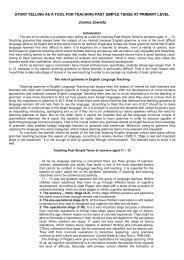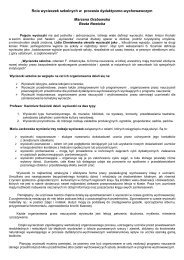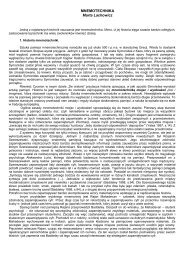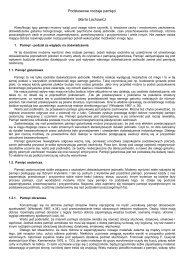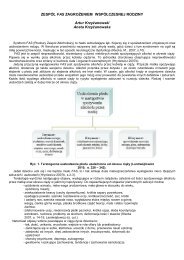On application of visuals in teaching English; selected issues ...
On application of visuals in teaching English; selected issues ...
On application of visuals in teaching English; selected issues ...
You also want an ePaper? Increase the reach of your titles
YUMPU automatically turns print PDFs into web optimized ePapers that Google loves.
F.L. Billows suggests that <strong>visuals</strong> can be divided <strong>in</strong>to three ma<strong>in</strong> groups: 9<br />
1) 2-dimensional aids – <strong>in</strong>clude wide variety <strong>of</strong> pictures and draw<strong>in</strong>gs, such as all k<strong>in</strong>d <strong>of</strong> pictures, postcards,<br />
posters and magaz<strong>in</strong>es, maps and plans, tables, charts, diagrams, graphs, m<strong>in</strong>d maps and time l<strong>in</strong>es, picture<br />
stories, cartoons and comic strips, film, video, television, c<strong>in</strong>ema and OHP transparencies and slides.<br />
2) 3-dimensional aids which mean teacher’s and students’ body language (mimes, gestures, facial expression,<br />
act<strong>in</strong>g a situation, puppets)<br />
3) other visual aids - almost everyth<strong>in</strong>g that presents <strong>in</strong>formation visually and is used <strong>in</strong> teach<strong>in</strong>g process. These<br />
are realia such as a calendar, a clock, a mirror, toys and art: (pa<strong>in</strong>t<strong>in</strong>gs, albums, sculptures).<br />
As has been already stated, visual aids have many different forms, but they have someth<strong>in</strong>g <strong>in</strong> common – they mean<br />
all events <strong>of</strong> human communication which transcend spoken or written language. They are used as a medium <strong>of</strong><br />
convey<strong>in</strong>g a message <strong>in</strong> iconic code and play important role <strong>in</strong> a communication system.<br />
2. Factors which <strong>in</strong>fluence the choice <strong>of</strong> visual aids<br />
Visuals are thought to be suitable for all levels and age groups, but not every visual is appropriate to every class. We<br />
must judge for ourselves if the materials matches the needs <strong>of</strong> the pupils. Andrew Wright presents a chart with a wide<br />
range <strong>of</strong> factors that should be considered before choos<strong>in</strong>g supplementary materials. He divides them <strong>in</strong>to three groups: 10<br />
1) Factors connected with learn<strong>in</strong>g situation:<br />
a. Pupil<br />
Students’ age is probably the most important factor. Not only topics but also applied methods, techniques and aids<br />
should be relevant to it. The younger the students are, the simpler (less detailed), more colourful pictures and the shorter<br />
films should be presented. Accord<strong>in</strong>g to Jan Rusiecki, films generally are not appropriate for young pupils. He argues that<br />
there are too many changeable elements, too fast tempo and almost no repetition. He writes that the sequence <strong>of</strong><br />
pictures is more suitable for use with children. The only exception are films specially made for teach<strong>in</strong>g purpose. They are<br />
adopted to the level and practice specific structures or vocabulary. 11<br />
While teach<strong>in</strong>g young pupils very effective is the use <strong>of</strong> <strong>visuals</strong> such as puppets, toys and real objects, which give<br />
them the chance to touch and manipulate th<strong>in</strong>gs. They also take advantages <strong>of</strong> picture stories, cartoons and comic strips.<br />
Tables, charts and diagrams, although help to organize new material, are usually more appropriate for elder learners.<br />
Students’ age is not the only factor which <strong>in</strong>fluences the choice <strong>of</strong> teach<strong>in</strong>g aids. There are more pupils’ <strong>in</strong>dividual<br />
differences that should be considered. These are their abilities, motivation, character, <strong>in</strong>terests, social and cultural<br />
backgrounds and their previous experience <strong>of</strong> the language. Komorowska po<strong>in</strong>ts out that students from neglected<br />
backgrounds tend to show traits and needs typical for younger age group. 12<br />
What is more, students present certa<strong>in</strong> level <strong>of</strong> pr<strong>of</strong>iciency <strong>in</strong> target language. Even the elder students who beg<strong>in</strong><br />
<strong>English</strong> learn<strong>in</strong>g, need topics and teach<strong>in</strong>g aids suitable not only for their age but also for their language level. A general<br />
rule is that materials should be slightly higher <strong>in</strong> their level <strong>of</strong> difficulty than the students' current level <strong>of</strong> <strong>English</strong><br />
pr<strong>of</strong>iciency.<br />
Furthermore, students’ <strong>in</strong>telligence and lateralization also impact their ability to take advantages <strong>of</strong> different<br />
supplementary materials. Especially those with visual <strong>in</strong>telligence and right bra<strong>in</strong> hemisphere predom<strong>in</strong>ance need more<br />
non-verbal means.<br />
b. Environment<br />
Teach<strong>in</strong>g <strong>in</strong>volves the creation <strong>of</strong> environment and activities that effectively <strong>in</strong>voke learn<strong>in</strong>g. Technology, such as<br />
OHP, slides, video and computers supports learn<strong>in</strong>g, but there are many classrooms which are not equipped so well.<br />
When the <strong>English</strong> language classroom is <strong>of</strong> poor physical and technical conditions, a teacher has no choice and has to<br />
resign from us<strong>in</strong>g <strong>visuals</strong> that require technology. What s/he can do <strong>in</strong>stead <strong>of</strong> this, is to balance out disadvantages <strong>of</strong><br />
classroom by the wide variety <strong>of</strong> other visual aids.<br />
First <strong>of</strong> all, it is obvious that a safe, comfortable and attractive classroom stimulates learn<strong>in</strong>g and helps build a<br />
classroom community. A great idea then is to decorate the walls. Attractive visual aids, such as bullet<strong>in</strong> boards and<br />
posters, are key components <strong>of</strong> an effective classroom. Wall decorations should be colorful, appeal<strong>in</strong>g and relevant to<br />
current class work. They should be rotated and refreshed frequently.<br />
What is more, it could be very useful to create a students’ work display and present children’s draw<strong>in</strong>gs and projects.<br />
It would make them proud <strong>of</strong> their contribution to classroom decoration and will be a very motivat<strong>in</strong>g factor.<br />
Furthermore, David A. Hill po<strong>in</strong>ts that teach<strong>in</strong>g language is teach<strong>in</strong>g the culture <strong>of</strong> the people who speak that<br />
language and has a lot <strong>of</strong> references to th<strong>in</strong>gs which are alien to a foreign language learner. He writes: “if the explanation<br />
is accompanied by a visual image - where appropriate - the learner will understand far better: the picture makes the<br />
9 F.L.Billows (translated by B.Jasińska, B.Pawłowska), Technika nauczania języków obcych (Warszawa: Państwowe Zakłady<br />
Wydawnictw Szkolnych, 1968), 138-163.<br />
10 Andrew Wright, “Audio-Visual Materials <strong>in</strong> Language Teach<strong>in</strong>g”, The Ed<strong>in</strong>burgh Course <strong>in</strong> Applied L<strong>in</strong>guistics, vol.3<br />
(London: Oxford University Press, 1974), 266-269.<br />
11 Jan Rusiecki, O nauczaniu języków obcych (Warszawa: Państwowe Zakłady Wydawnictw Szkolnych, 1964), 135-136.<br />
12 Komorowska, Metodyka, 38-40.



